A Beginner’s Guide to Making Money by Flipping Items
6 Tips for Starting and Keeping a Flipping Side Hustle on Facebook Marketplace
Guest Post by Anita from The Retired Millennial
For anyone with free time, interest in a new hobby, or a gap in their income, flipping is a great side hustle to consider. There is no limitation on what you can make and no advanced skills are needed — you only need some time, and a Facebook account.
If you don’t know what flipping is, flipping is when you buy something that costs a certain amount and sell it for more than your cost in order to make a profit.

I recommend starting on Facebook Marketplace because of the number of users on the platform and low seller fees. According to statista.com, at the beginning of 2020, Facebook had 223 million users in the US. [1] eBay, for reference, had 183 million worldwide in 2020 [2]. If you sell items locally, there are no seller fees, but if you offer nation-wide shipping, the seller fee is only 5%. So with all of those eyes on your product, your item is likely to sell, and with the zero/low fee, your earnings will be higher.
This article will give any beginner 6 tips on starting and keeping a successful side hustle. This method does not involve paying to boost your listings, though you can also still gain a lot of insight by reading this and choosing to boost your items on top of what I share here.
1. Source zero or low-cost inventory that will likely sell
This is the best tip I can give to beginners because as you start this process, you will be experimenting with selling various items, and keeping the cost low not only increases your profit margin but also decreases a possible loss. For the first three months, I recommend not spending more than $5 per item unless you know the item will sell. Having low-cost inventory also helps with getting the item off of your hands quickly because it puts you in a business position where you can list the item for a bargain if it sits around — you still make a profit, and the buyer can get a great deal.
If you want zero dollar inventory (meaning items that you paid zero dollars for), you can consider gifts that are collecting dust around your house (and wouldn’t be controversial letting go of), free curbside items that you can either seek out on Facebook Marketplace by scrolling or setting a search alert, or even dumpster dive at apartment complexes or big box stores near you.
Low-cost inventory could be found at thrift stores, and thrift outlets that sell items by the pound, and garage sales. You can also look for new or open box items at places like Falling Prices, where Amazon returns end up and the prices fall each day of the week.
During your first couple of months, you will find what works for you. Once you find your favorite source, make a schedule to regularly visit. I personally have found a good rhythm at my local Goodwill Outlet, where things are sold by the pound, and frequent it 1–2 times a week.
You can decide if you want to focus on one category of items that you buy & sell, or one theme, or on a price range, or be open to a combination of items and price points. At first, you will likely gravitate towards items that you would personally buy, and that is an okay place to start, but be aware of that bias and be willing to learn about other brands or items that sell well when you source.

If you are ever uncertain of the likelihood that the item will sell, there are two ways I find out 1) check eBay completed items 2) trial and error. While you don’t have to sell your items on eBay, using eBay can still be helpful in assessing the worth and determining how sellable the item is. This is not a perfect process since prices and demand vary across all platforms. What sells on eBay may not sell on Facebook, but it’s a pretty good baseline. Get the eBay app, search the item you see, and filter by “completed listings.” Whatever sold will show the dollar amount in green, and this is more important than the number people are selling it for, so look for the number in green. This will give you an idea of the worth of the item and how many are selling. This is a good baseline for your item — keep in mind that you could still list your item on FB Marketplace for more or less than what your research finds. Once you know the “worth” of the item, you can calculate if you’re okay with the profit you will get. Just because it’s selling, doesn’t mean you should buy it to flip.
Profit = price of sale — cost of item — fee — shipping (if you pay for shipping)
The second method is trial and error. If the item is only costing your cents or dollars, you can see how that item does by taking a chance on it. Some items I found that sold by trial and error were pet steps and plant holders. I was getting so many messages for these listings and they sold so quickly, so when I see pet steps and plant holders for cheap, I buy them.
Not sure what items to source for? If you need a category recommendation of things to the source to start your journey, go to Facebook Marketplace from the mobile app, click “Your Account” (the person icon) > “Insights” and then “See Popular Categories.” That will show you current popular categories and what items people are searching for. These categories change over time, so check back.
2. Increase exposure with shipping, groups, and keywords
Whenever you list, always think about exposure. The more exposure, the higher the chances of your item (quickly) selling. To gain exposure and increase the views on your listing, use keywords in your titles and descriptions and tags, offer shipping, and share your listing to relevant Facebook Groups.
You can share your item on Facebook groups. Usually, your town will have its own marketplace. You can look up “<name of your town> sales” and see what groups are nearby. If you sell antiques, for example, you can also join antique groups and post antiques there.
Not everything can be shipped, but if you have an eligible item to ship, offer shipping. You can either build the shipping cost into the price and offer “free shipping” or you can just let the buyer pay shipping (I recommend starting by letting the buyer pay for shipping). You will need a printer to print the label, and scale, and need boxes or mailers if you plan to ship from home. Otherwise, you can take your item to the post office yourself. I highly recommend doing it at home after you know this is a side hustle you want to stick with.
You can also start with local pick up only, and use Facebook Groups and appropriate keywords as your main means of exposure. Which keywords should you use? Think of what someone would search for when they look for your item. If you want to see what actual words people are using, you can go to the insights section of Facebook Marketplace, and see what keywords people are searching across popular categories.
I will note that you can also choose to “boost” your item for a range of money, which will turn your listing into an ad, and increase your reach. I personally choose to widen my profit margin, and I do not pay for a boost and still have been making $500-$1,000 a month in profit without boosting.
3. Re-visit sitting inventory
Some items will end up sitting, so the question becomes, “what do you do with items that are sitting for a while?” You can not only renew the item as is but lowering your price can also attract people who viewed or saved your item. If you’re looking for a quick flip, look at the views and shares your items have, as if there are any saves, these are great items to lower the price on. The user will be notified when the price lowers. By listing your item for 20–30% more than what you are willing to get for it, will bring the cost down to your bottom number.
You can either wait a week to renew or do it the next day if the listing has saved and you want it gone.
I don’t really recommend boosting items that are sitting. If they didn’t quickly sell by using the right keywords and offering shipping and posting to groups, it probably won’t sell with a boost.
4. Follow other resellers
Following other resellers will normalize this line of work for you. If you’re new to flipping and don’t personally know anyone who does it, it can feel strange at first. When you see people with all backgrounds doing this all over the country and world, it really gives you the confidence you need as a beginner. Not only will they encourage you, but you can take note of what items are selling for them (and keep your eye out for them). You can follow the #resellercommunity hashtag on Instagram to see a variety of resellers.
5. Consider the 8 part listing rule
Having the right item only brings you halfway to the sale. Listing your item takes you to the finish line. Below is one of the most viewed items that I priced up and then sold to someone who put an offer in. Hitting all 8 of these points will increase your chances of your item showing up when people search for it.

What was the result of this listing? Only after being up for a couple of hours, you can see that it had 1,180 views, 20 saves, and 8 listing shares. I ended up selling it for $30 the next day. With those stats, I could have sold it for $35 — $45, but with my busy schedule, I try to eliminate as much adjusting as possible and go for what is quick. Considering it only cost me about $5, a $25 profit was great for me (there was a 0% seller fee promotion on this one).
So what did I do? Let’s look at the anatomy of this listing:
- I took several photos of the item. The item was clearly shown, and you could see the scale of the item. I took photos of all of the angles. *The photo is the most important part of the listing*. People buy with their eyes, and sometimes don’t even read the description or even the title of the item. Take many clear photos and choose a nice cover photo.
- The next part is the title. While some people don’t read it, why should you bother with giving this much thought? The keywords still help bring up your listing when it’s searched. Include the item description, brand name, and what you think someone might search for in the title.
- Price the item up from what you want to get for it to leave room for offers and price drops.
- Fill in the details section as this helps with search relevancy — while the buyer may not read it, it will help in getting this listing in front of them.
- Offer shipping, as it will increase your reach. Remember, 223 million users in the US!
- In your description, copy and paste the title, then add a note about the condition, and then how the buyer can purchase your item.
- Tags are another way that your listed item will find its way to the right buyer.
- List your item on local marketplace groups to expand your reach! Selling locally is great because you can avoid having to pay a seller’s fee that comes with selling via shipped orders.
6. Start Today
All beginners need momentum, so I recommend that you start by listing something that is already in your home — right now. Find something that costs you $0 or something you really don’t need anymore. Take a clear picture of it, list it for 20% more than what you want for it, use keywords on the title, write a description of the condition and how the buyer can purchase it. Once you sell it, use that profit for more inventory, or shipping supplies.
Happy flipping! Feel free to check out my $0-$1k experience here, a challenge where I went from $0 — $1k by flipping items. Follow me on Instagram at @the.retired.millennial to see every flip I’ve done in my highlights “0–1k” and “0–1m”
Here are tools that you will eventually need if you decide to stick to it and ship from home
- Free USPS priority boxes — you can use these for any priority labels, and buy for free on www.USPS.com
- Buy mailers and shipping tape at www.upaknship.com — it’s the cheapest on the market and its great quality
- Buy a scale if you plan on shipping. I have this one.
- If you’d like to graduate from your printer, get a thermal printer. Ralli Roots recommends this one. I personally don’t own one yet. You can also look on eBay or Facebook marketplace for a used one!
References
[1] https://www.statista.com/statistics/408971/number-of-us-facebook-users/
Guest Author
Anita invests her time creating software for the US Department of Defense, and mentoring the future generation of computer scientists at her local university. She enjoys California’s beautiful Central Coast, and documents her journey to financial independence as “The Retired Millennial.” She loves people and organizations that practice philanthropy and embrace diversity.
Follow Anita on Instagram @the.retired.millennial



